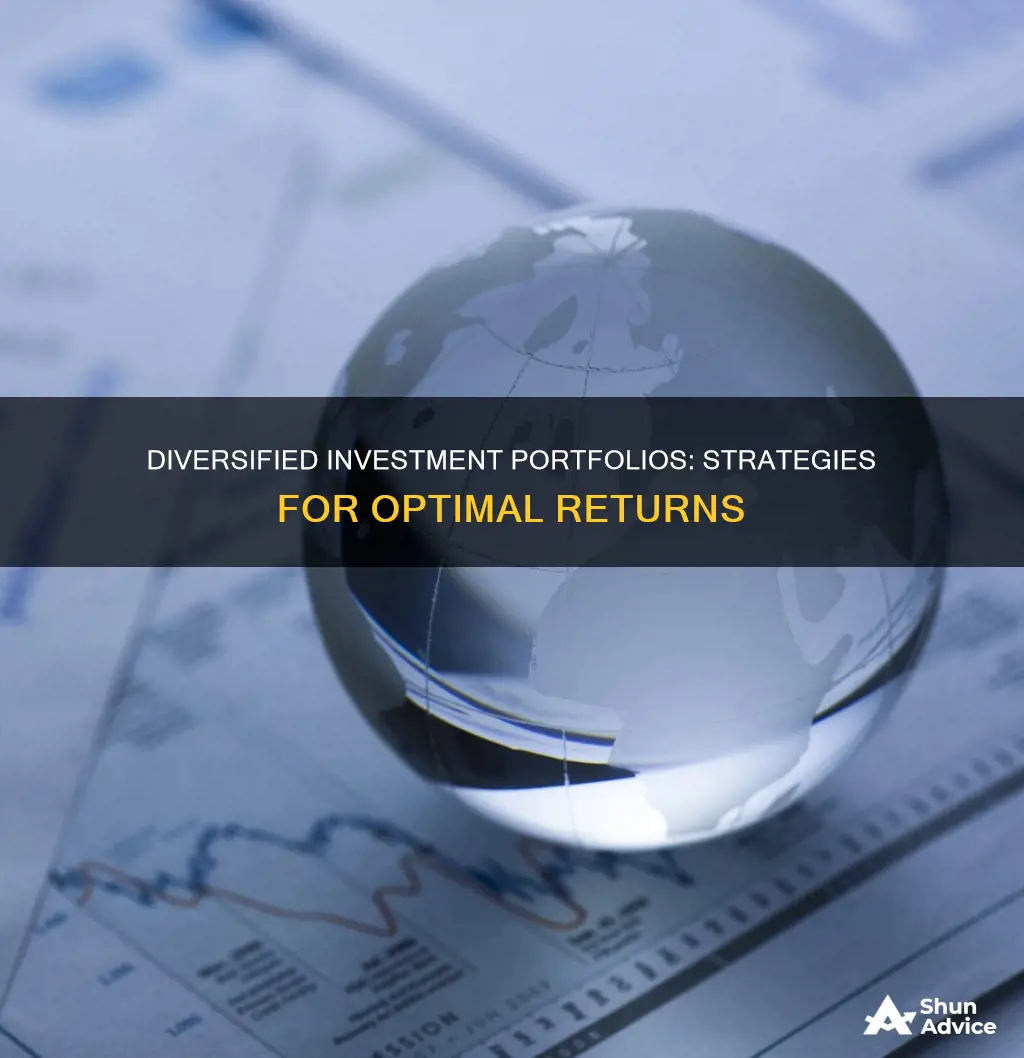
Diversification is a risk management strategy that creates a mix of various investments within a portfolio. A diversified portfolio contains a mix of distinct asset types and investment vehicles in an attempt to limit exposure to any single asset or risk.
The rationale behind this technique is that a portfolio constructed of different kinds of assets will, on average, yield higher long-term returns and lower the risk of any individual holding or security.
- S&P 500 Index Fund — This fund invests in 500 of the largest public US companies, providing exposure to a diverse range of industries.
- Vanguard Australian Government Bond Index ETF — This ETF offers exposure to Australian government bonds, which are considered low-risk investments.
- iShares Core U.S. Aggregate Bond ETF (AGG) — AGG tracks the Bloomberg U.S. Aggregate Index, which includes a diverse range of US Treasurys, mortgage-backed securities, and corporate bonds.
- iShares MSCI Global Energy Producers ETF (FILL) — FILL provides exposure to global energy stocks, including the five super-major companies Exxon Mobil, Chevron, Shell, BP, and TotalEnergies.
- Avantis U.S. Small Cap Value ETF (AVUV) — This ETF offers active management and focuses on investing in smaller and undervalued companies with higher growth potential.
| Characteristics | Values |
|---|---|
| Number of stocks | 25-30 |
| Industries | Various |
| Countries | Various |
| Risk profiles | Various |
| Other investments | Bonds, commodities, real estate, cryptocurrencies, cash, precious metals, alternative investments |
What You'll Learn

Diversify across asset classes
Diversifying across asset classes is a crucial aspect of building a robust investment portfolio. Here are some detailed insights on how to achieve effective diversification:
Understanding Asset Classes
Firstly, it's essential to understand what constitutes an asset class. Traditional asset classes include stocks, bonds, and cash. However, modern investors often include alternative investments, such as real estate, commodities, and private equity, in their portfolios. Each asset class has unique characteristics, and they respond differently to changing economic and political conditions.
Benefits of Diversifying Across Asset Classes
By diversifying across asset classes, you increase the probability that some of your investments will generate satisfactory returns, even if others underperform or lose value. This strategy helps to balance your portfolio's growth and risk. For instance, stocks are typically more volatile and provide higher growth potential over the long term, while bonds are considered less volatile and provide regular interest income.
Strategies for Diversification Across Asset Classes
- Individual Asset Diversification: This involves investing in a range of assets within an asset class. For example, buying the market index, such as the S&P 500 or Russell 2000, ensures you hold a variety of high- and low-risk stocks across industries.
- International Market Diversification: Investing in international markets helps mitigate risks associated with your home country's market performance. However, be mindful of different regulations and processes for investing in other countries.
- Asset Class Diversification: This strategy involves investing across traditional and alternative asset classes. Alternative investments, such as hedge funds, private equity, real estate, and commodities, tend to have low correlations with traditional assets, making them valuable additions to your portfolio.
Factors to Consider
When diversifying across asset classes, consider the following:
- Time Horizon and Liquidity: Traditional investments like stocks, bonds, and cash have no set time horizon and are highly liquid. In contrast, alternative investments typically have longer time horizons and are relatively illiquid.
- Markets and Industries: Diversify across various industries and markets. For private equity or debt investments, explore industry trends, and for real estate, spread your capital across different types of properties or geographic locations.
- Risks and Potential Threats: Alternative investments offer varying levels of risk. Longer time horizons often equate to lower risk as the market has more time to correct itself. However, for physical assets, longer time horizons may increase the risk of damage, theft, or loss.
Monitoring and Rebalancing
Remember that diversification is an ongoing process. Regularly monitor your portfolio to ensure it aligns with your target allocation. As market performance changes the values of your asset classes, you may need to adjust your holdings. While there is no official timeline for rebalancing, consider reviewing your portfolio annually and making adjustments as needed.
By diversifying across asset classes and incorporating traditional and alternative investments, you can effectively spread your risk, increase your potential for returns, and build a robust investment portfolio.
Saving and Investing: Economy's Growth Engine
You may want to see also

Diversify within asset classes
Diversifying within asset classes is a crucial aspect of achieving a well-diversified investment portfolio. Here are some detailed strategies and considerations for diversifying within different asset classes:
Stocks
Diversifying within stocks involves owning multiple stocks from different industries, sectors, and geographies. This means investing in a mix of tech, energy, healthcare, and other sectors, ensuring that you hold stocks from both domestic and international markets. Additionally, consider investing in companies of different sizes, such as small-cap, medium-cap, and large-cap companies. This type of diversification helps protect your portfolio from industry-specific or region-specific risks.
Bonds
When investing in bonds, it is important to diversify by choosing bonds from different issuers, such as the federal government, state and local governments, and corporations. Also, consider selecting bonds with different terms and credit ratings to further diversify your bond holdings. This approach helps reduce the impact of any specific issuer or credit-related risks.
Real Estate
To diversify within real estate, consider investing in a mix of residential, commercial, and retail properties. Additionally, spread your investments across different geographic locations to minimize the impact of region-specific factors on your portfolio. Real estate investment trusts (REITs) can be a great way to easily gain exposure to a diversified portfolio of income-producing commercial real estate.
Commodities
When investing in commodities, consider a range of natural resources, such as oil, agricultural products, timber, and precious metals. By diversifying across different types of commodities, you reduce the risk associated with any single commodity's price fluctuations.
Mutual Funds and Exchange-Traded Funds (ETFs)
Even when investing in pooled investments like mutual funds or ETFs, it is important to ensure diversification. Look for funds that invest in a broad range of underlying securities and avoid overlapping investments. For example, owning multiple mutual funds that all invest in the same subclass of stocks does not provide effective diversification.
Alternative Investments
Alternative investments, such as hedge funds, private equity, debt investing, and collectibles, can also be part of a diversified portfolio. These investments tend to have low correlations with traditional assets, providing further diversification benefits. Consider the time horizon, liquidity, market trends, and risk levels associated with each type of alternative investment to make informed decisions.
The Importance of Maintaining Your Investment Portfolio
You may want to see also

Diversify beyond asset classes
Diversification is a crucial concept in investing, and it involves spreading your investments across various assets to reduce risk and enhance returns. While the traditional approach focuses on diversifying within asset classes like stocks, bonds, and cash (or cash equivalents), diversifying beyond asset classes can further strengthen your portfolio. Here are some strategies to achieve diversification beyond asset classes:
Include Real Estate:
Real estate is a practical way to diversify your portfolio. Consider investing in Real Estate Investment Trusts (REITs), which are traded on major exchanges and provide an easy and cost-effective alternative to direct property ownership. REITs invest directly in property and mortgages, typically offering high yields. Additionally, real estate has a relatively low correlation with stocks, making it an effective diversification tool.
Explore Precious Metals:
Precious metals, such as gold, can be a valuable addition to your portfolio. Gold, in particular, is known for its ability to maintain its value over time and acts as a hedge against inflation and adverse market conditions. It is often considered a "safe haven" asset during times of market turmoil.
Consider Currencies:
Currencies can play an important role in diversification. While holding cash over the long term is generally not advisable due to low yields and inflationary impacts, diversifying into different currencies can provide stability. For example, investing in stable currencies like the Swiss franc can offer a benchmark against which to measure the performance of your investments.
Explore Alternative Investments:
Look beyond traditional asset classes and consider alternative investments such as cryptocurrencies, commodities, or other tangible assets. These investments often have a lower correlation with the stock market and can enhance the diversification of your portfolio.
Utilize Investment Products:
Diversify your portfolio by allocating funds to different investment products, such as pensions, annuities, and insurance. These products offer guaranteed income streams and returns, providing a level of stability that complements the non-guaranteed returns of traditional investment accounts.
Remember, the key to successful diversification is to spread your investments across a wide range of assets, reducing your exposure to any single asset or market sector. By diversifying beyond asset classes, you further mitigate risk and enhance the potential for long-term returns.
Building a Solid Investment Portfolio with a $2,000 Foundation
You may want to see also

Diversify across platforms
Diversifying across platforms is a crucial aspect of investment portfolio management, and it involves holding assets in different ways to mitigate risk. Here's a detailed explanation:
Diversification Across Platforms:
Diversification is not just about investing in various asset classes, industries, or geographical locations but also about how those assets are held. This aspect adds another layer of risk consideration, separate from the investment's inherent risk.
For example, consider an individual with a large sum of cash. They have the same asset allocation in all three scenarios below, but their risk profile differs:
- Bank Deposits at Multiple Institutions: The individual may choose to deposit half of their money in one bank and the other half in another bank. This way, both deposits are insured and protected, with each bank having its own FDIC insurance limit.
- Single Bank Deposit: If the entire sum is deposited in a single bank, only a portion may be covered by insurance. Additionally, if that bank experiences a run, the individual may face challenges accessing their funds immediately.
- Physical Cash Storage: The individual could decide to keep all the cash at home. While this provides immediate access, it earns no interest, and there are risks of theft, fire, or misplacement.
The same concept applies to various asset classes. For instance, the inability to withdraw or transfer funds from a cryptocurrency exchange due to bankruptcy could have been mitigated by diversifying across different platforms or exchanges.
Strategies for Diversification Across Platforms:
- Physical and Financial Assets: Diversification can be achieved by owning both physical and financial assets. For example, owning physical gold bars and gold exchange-traded funds (ETFs) provides diversification across various risks. If the physical gold is stolen, you still retain a portion of your gold investment through the ETFs.
- Multiple Financial Institutions: Holding assets across multiple financial institutions can reduce risk. For instance, depositing funds in different banks or investing through various brokerage platforms can protect against the failure of a single institution.
- Different Investment Vehicles: Utilizing various investment vehicles, such as mutual funds, exchange-traded funds (ETFs), and direct stock ownership, can provide diversification across platforms. Mutual funds, for instance, offer instant diversification at a low cost.
- Tangible and Intangible Investments: Diversification can be achieved by investing in both tangible and intangible assets. Tangible assets include real estate, precious metals, commodities, and collectibles, while intangible assets are financial instruments like stocks and bonds.
Benefits of Diversification Across Platforms:
Diversification across platforms offers several advantages:
- Risk Mitigation: It helps to spread the risk associated with holding assets in a single form or location. By diversifying across platforms, you reduce the likelihood of complete loss due to unforeseen events like bankruptcy, fraud, or physical disasters.
- Interest and Growth: Holding assets across different platforms can provide opportunities for interest and growth. For example, depositing funds in banks can earn interest, while investing in stocks through different brokerage platforms may offer capital appreciation potential.
- Accessibility and Liquidity: Diversification across platforms can enhance accessibility and liquidity. Holding assets in multiple locations or institutions ensures that you are not entirely dependent on a single source for accessing your funds.
- Protection Against Technology and Physical Risks: Diversifying across platforms can offset technology and physical risks. For instance, if an online brokerage platform experiences technical issues, you still have access to your investments held with other brokers or in physical form.
Considerations and Challenges:
While diversifying across platforms is beneficial, there are some considerations:
- Time and Management: Holding assets across multiple platforms can be time-consuming to manage and may require additional effort to track and maintain records, especially for tax purposes.
- Transaction Fees and Costs: Diversification across platforms may incur higher transaction fees, brokerage commissions, and other costs associated with buying and selling assets through different institutions.
- Overdiversification: It is important to strike a balance and avoid overdiversification, where the addition of new platforms increases overall risk and reduces expected returns without a corresponding reduction in risk.
Understanding the Domestic Saving-Investment Imbalance
You may want to see also

Diversify across industries
Diversifying across industries is a crucial aspect of building a robust investment portfolio. Here are some detailed tips to help you diversify across industries effectively:
Diversification Strategies:
- Spread Your Investments: Avoid putting all your eggs in one basket. Diversify your portfolio by investing in a variety of industries and sectors. This strategy helps to reduce the impact of negative events or downturns in any single industry. For example, if you invest in multiple industries such as technology, energy, healthcare, transportation, and consumer staples, a setback in one industry won't affect your entire portfolio.
- Index Funds: Consider investing in index funds such as the S&P 500, which tracks the performance of 500 large US companies across various industries. Index funds offer instant diversification and take the guesswork out of investing. They are also generally associated with lower fees, known as expense ratios.
- Fixed-Income Investments: Allocate a portion of your portfolio to fixed-income assets like bonds, certificates of deposit (CDs), and money market funds. These investments tend to be less volatile and can help lower the overall risk profile of your portfolio. While they may reduce average annual returns, they can mute losses in downturns and cut down years with negative returns.
- Real Estate: Explore investing in real estate, either directly or through Real Estate Investment Trusts (REITs). REITs own income-producing commercial real estate and have historically increased portfolio returns while reducing volatility. They can also serve as a hedge against inflation.
- Geographic Diversification: Don't limit yourself to domestic investments. Consider investing in international stocks and companies from different countries, as they often perform differently than their US counterparts and can provide exposure to new opportunities.
- Asset Classes: Diversify across different asset classes, such as stocks, bonds, money market funds, and alternative investments. Each asset class behaves differently based on macroeconomic conditions. For instance, rising interest rates may positively impact equity markets but push down bond prices.
- Company Diversification: Don't put all your faith in one company, even if it's your favorite. Invest in multiple companies within an industry to mitigate company-specific risks, such as leadership changes or consumer preference shifts.
- Time Frames: Consider the time horizon of your investments. Long-term investments, like long-term bonds, often carry more risk but may offer higher returns. Short-term investments, on the other hand, tend to be more liquid and less risky but usually yield lower returns.
Best Practices:
- Number of Investments: While diversifying is essential, don't overextend yourself. Aim for a manageable number of investments that you can comfortably research and track. According to experts, 20 to 30 different investments is a reasonable range.
- Risk Tolerance: Understand your risk tolerance and time horizon. If you are closer to retirement or have a lower risk tolerance, consider a more balanced portfolio with fixed-income investments. Younger investors, on the other hand, can afford to take on more risk by allocating a larger portion of their portfolio to stocks.
- Regularly Review and Rebalance: Diversification is an ongoing process. Regularly review your portfolio to ensure it aligns with your investment goals and risk tolerance. Make adjustments as necessary to maintain a balanced portfolio.
Remember, diversification is a powerful tool for managing risk and enhancing returns, but it does not guarantee profits or completely eliminate risk. It's important to stay informed about your investments and be proactive in managing your portfolio.
Savings or Investing: Where Should Your Money Go?
You may want to see also
Frequently asked questions
Diversification is a risk management strategy that combines different investments to reduce an investor's overall risk. It involves spreading investment money across a range of assets, such as stocks, bonds, real estate, and cryptocurrencies. The goal is to limit exposure to any single asset or risk, with the understanding that some assets will perform well while others do poorly.
Diversification helps to reduce the overall risk of a portfolio while potentially increasing overall returns. It also helps to smooth out unsystematic risk events, with the positive performance of some investments neutralising the negative performance of others. Additionally, a diversified portfolio may result in a larger profit if extended into asset classes that wouldn't otherwise be invested in.
Diversification can be achieved by investing in different asset classes, such as stocks, bonds, real estate, and cryptocurrencies. It can also be achieved by purchasing investments in different countries, industries, company sizes, and term lengths for income-generating investments. A good rule of thumb is to own at least 25 different companies across various industries.
Diversification may limit gains in the short term. Additionally, managing a diversified portfolio can be time-consuming, and buying and selling holdings may result in higher transaction fees and brokerage commissions.







